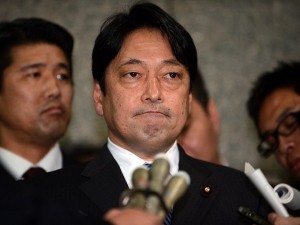China, Russia deny Japanese accusations

Japanese Defense Minister Itsunori Onodera speaks to reporters at the Defense Ministry in Tokyo on February 5, 2013. A Chinese military frigate locked its weapon-targeting radar on a Japanese navy vessel on at least one occasion last month, in an apparent upping of the stakes in a bitter territorial row. AFP/Yoshikazu TSUNO
TOKYO—Japan’s defense minister on Friday accused two Russian fighter jets of intruding into Japanese air space, heightening regional tensions as Beijing denied Tokyo’s claims that Chinese naval vessels had locked their weapons-targeting radar on to a Japanese destroyer last month.
Tokyo said two Russian Su-37 fighters entered Japanese air space off the northern tip of Hokkaido island for just over a minute Thursday, prompting Japanese air force jets to scramble to where the Russian jets were flying.
Russia denied any border violation, but Japanese Defense Minister Itsunori Onodera said Friday that Tokyo will deal with the incident “strictly, within the bounds of international law.”
The alleged intrusion happened when Japan was observing “Northern Territories Day,” when it holds annual rallies urging Russia to return a series of islands off eastern Hokkaido captured at the end of World War II. The islands, called the Southern Kurils in Russia, are 400 kilometers (250 miles) southeast of where the incident took place.
In Beijing meanwhile, China’s Defense Ministry issued a statement denying Japanese claims that Chinese naval vessels had locked their radar on to a Japanese destroyer and helicopter in two instances last month in the East China Sea.
The countries are embroiled in a territorial spat over a cluster over tiny, uninhabited islands — called Senkaku in Japanese and Diaoyu in Chinese — in the vicinity that are controlled by Japan but also claimed by China and Taiwan.
“The Japanese so-called claims that the Chinese navy locked on to Japanese ships and aircraft with fire control radar are not factual,” the Chinese statement said.
It also accused Japan of repeatedly fabricating reports to smear China over the normal training actions of its military and building China up into an international threat.
“The Chinese side wishes that the Japanese side take practical actions, cease creating a tense atmosphere in the East China Sea, and refrain from issuing irresponsible statements,” it said.
Japanese Foreign Minister Fumio Kishida rejected Beijing’s denial as “completely unacceptable.” He told reporters that a thorough review of data by the Defense Ministry confirmed that the Chinese naval ship and locked on with its weapons targeting radar.
The US Navy has said that Chinese ships have in past switched on their fire control radar as a response to being hailed by US ships. Experts say this underlines the need for better communication and coordination between navies.
The verbal back-and-forth comes amid the rise of China and to a lesser extent Russia’s re-emergence as a major power in Asia, but doesn’t point to an imminent military conflict, said Narushige Michishita, a security expert at the National Graduate Institute for Policy Studies in Tokyo. “That’s been encouraging them to be more assertive and more active both on the diplomatic front and military front in this region.”
China and Russia may also be trying to test Japan’s new prime minister, Shinzo Abe, who has a reputation as a staunch nationalist and came to office late last year pledging to defend Japan’s sovereignty and get tough with neighbors in territorial disputes.
“In the short run, this is happening I think partly in reaction to Mr. Abe’s return to office,” Michishita said.
While a conflict between Japan and Russia is much less likely than with China, Russia’s alleged flight intrusion may be trying to send a signal to Tokyo not to take them lightly, he said. That the incident took place on a day when Japan was demanding the return of Russian-controlled islands seems intentional, he added.
Russian “military operations and diplomatic intentions are pretty well coordinated,” he said.
Photos of the Russian jets provided by Japan’s military indicate that Japanese fighters got relatively close. When a Japanese fighter aircraft scrambles towards foreign aircraft, it usually maintains a 2,000-foot (600-meter) distance to avoid possible collisions, Michishita said.
Collisions can happen. In 2001, a Chinese fighter collided with a US Navy EP-3 flying about 100 kilometers (60 miles) from the southern Chinese island of Hainan. The Chinese jet crashed, killing the pilot, and the US plane was forced to make an emergency landing on Hainan, where the 24 crew members were detained and interrogated by Chinese authorities.














